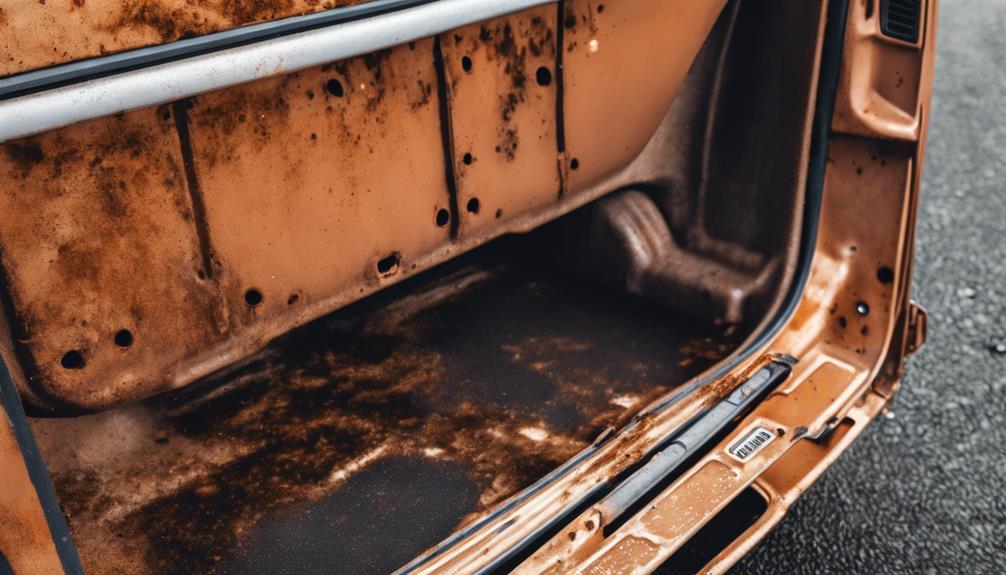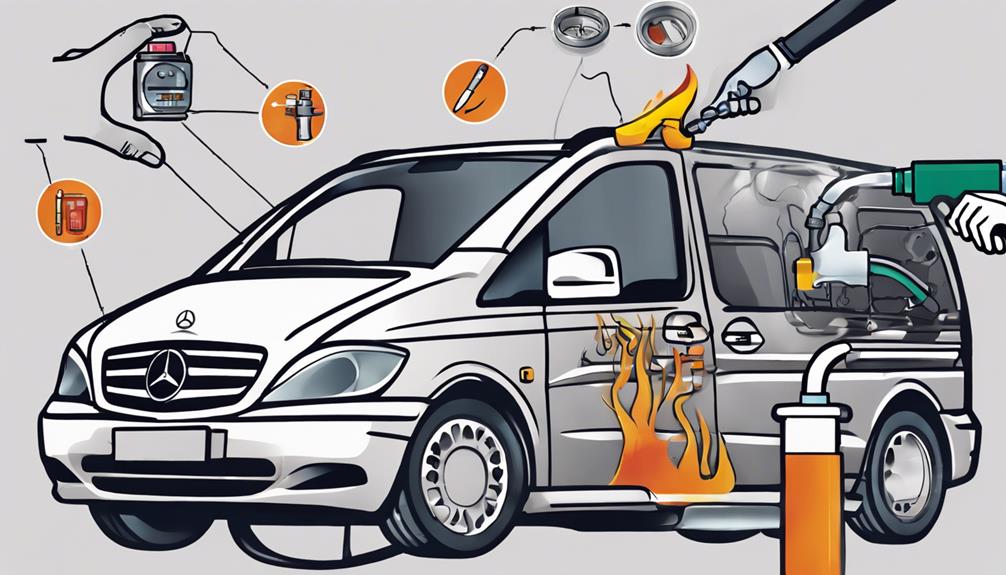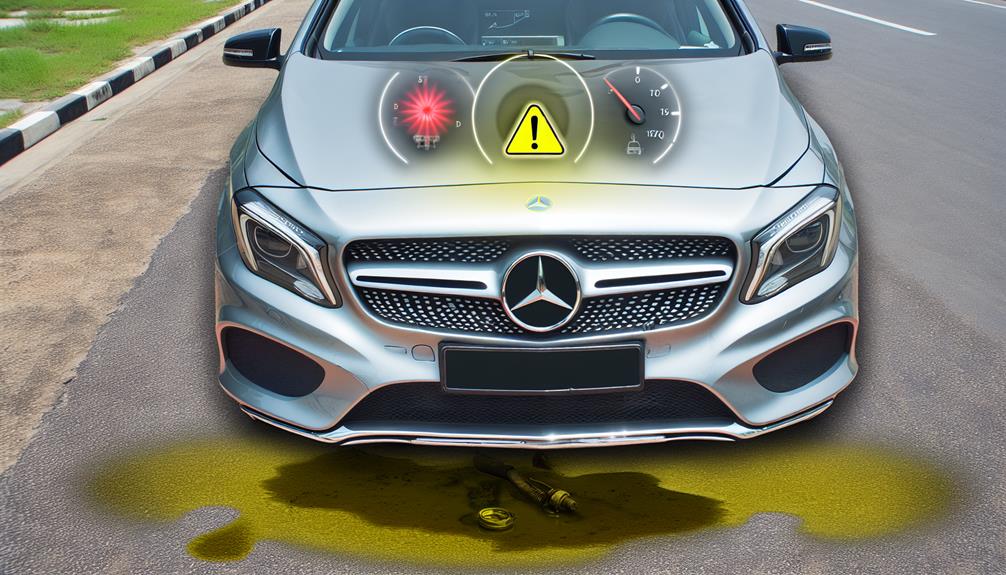If you're driving a Mercedes Vito, watch out for rust issues creeping along the sills and doors, engine overheating warnings signaling potential troubles, troublesome transmission failures, and gearbox glitches that may hamper your ride. Keep an eye out for signs of mechanical malfunctions like rough shifting and issues with the clock. The van's reliability can be hit or miss, with some quality concerns affecting its performance. Uncover more insights to steer clear of surprises.
Key Takeaways
- Rust issues common along sills and doors, especially in white vans.
- Engine overheating warnings signal potential serious engine issues.
- Transmission failures can disrupt driving, requiring immediate attention.
- Clock malfunctions may stem from electrical or software glitches.
- Injector problems manifest as rough idling, misfires, and performance drops.
Rust Issues

When combating the scourge of rust in your Mercedes Vito van, opting for colors like silver or graphite met can be a strategic move to enhance longevity and aesthetics while avoiding costly repairs. Rust, especially along sills and doors, is a common headache for Vito owners.
The white vans, in particular, seem to attract rust like moths to a flame due to subpar paint quality. Choosing silver or graphite met over white not only adds a touch of sophistication but also acts as a shield against the insidious advances of rust, saving you from the potential financial pitfall of frequent repairs.
It's like giving your Vito a stylish suit of armor, protecting it from the elements and ensuring that your van maintains its sleek appearance for years to come. So, next time you're eyeing a new paint job, remember: silver and graphite met aren't just colors; they're your Vito's rust-fighting companions.
Mechanical Malfunctions
You've revved up the engine in your Mercedes Vito, only to be met with the dreaded overheating warning light – a telltale sign of potential engine overheating issues.
As you shift gears, there's a lurking fear of transmission failure, a common concern that can throw a wrench in your driving experience.
These mechanical malfunctions can turn your smooth ride into a bumpy road of repairs and maintenance, making it important to stay on top of your Vito's health to keep it running smoothly.
Engine Overheating Issues
Experiencing engine overheating in your Mercedes Vito can point towards underlying mechanical malfunctions that require immediate attention and diagnosis. Issues like a faulty thermostat, water pump failure, or radiator blockages can lead to overheating. Common signs include steam from the engine bay, the temperature gauge hitting the red zone, and coolant leaks. Regular cooling system maintenance, such as checking coolant levels and quality, can help prevent these problems. Timely addressing of overheating is vital to avoid serious engine damage and costly repairs. Consult a qualified mechanic or Mercedes specialist to diagnose and resolve these issues promptly.
| Common Causes of Engine Overheating | Symptoms | Prevention Tips |
|---|---|---|
| Faulty thermostat, water pump failure, radiator blockages | Steam from engine bay, temperature gauge in red zone, coolant leaks | Regular cooling system maintenance, timely repairs |
Transmission Failure Concerns
Transmission failures in Mercedes Vito vans often stem from internal gearbox issues, leading to symptoms like rough shifting or delayed engagement when changing gears. Here are some pointers to help you navigate through potential transmission problems and keep your Vito running smoothly:
- Regular gearbox maintenance, such as fluid checks, can prevent costly repairs.
- Look out for signs of transmission trouble like slipping gears or unusual noises.
- Addressing any issues promptly can help avoid further damage to the gearbox.
- Consider consulting a professional if you notice persistent problems with shifting.
- Being proactive with maintenance can extend the lifespan of your Vito's transmission and save you from unexpected expenses down the road.
Gearbox Problems

When encountering gearbox problems in your Mercedes Vito van, be vigilant for signs such as grinding noises or gear engagement difficulties to prevent potential costly repairs.
Manual gearbox issues in Mercedes Vito vans can often be indicated by strange grinding sounds when shifting gears or experiencing resistance during gear changes. These symptoms may point towards underlying transmission problems that require immediate attention to avoid further damage.
Additionally, error codes related to gearbox malfunctions may appear on the vehicle's diagnostic system, providing vital insights into the specific issues affecting the transmission. Ignoring these warning signs could lead to more severe complications and result in expensive repairs down the line.
By addressing gearbox problems promptly and conducting regular maintenance checks, you can help prolong the lifespan of your Mercedes Vito van and ensure smooth driving experiences without the worry of unexpected breakdowns.
Clock Malfunctions
Detecting clock malfunctions in your Mercedes Vito van requires attention to subtle indicators that may signal underlying issues with internal components or software. When your Vito's clock starts acting up, it's crucial to tackle the problem promptly to avoid potential complications down the road. Here are some key points to bear in mind:
- Faulty Internal Components: Clock malfunctions in the Vito can often be traced back to defective internal parts.
- Inaccurate Time Readings: One of the primary signs of a clock malfunction is when the time displayed is incorrect or fluctuates unexpectedly.
- Electrical System Problems: Clock issues may be linked to broader electrical system malfunctions within the vehicle.
- Software Glitches: Sometimes, the culprit behind a malfunctioning clock is a software glitch that requires troubleshooting.
- Diagnostic Testing: To pinpoint the exact cause of the clock malfunction, diagnostic testing may be necessary, potentially leading to component replacements.
Stay ahead of the clock by addressing these malfunctions promptly to keep your Mercedes Vito running smoothly.
Injector Issues

Clock malfunctions are just the tip of the iceberg when it comes to the challenges faced by Mercedes Vito owners; another common headache is dealing with injector issues. The injectors in your Vito play an essential role in delivering fuel to the engine, but when they start acting up, you might experience rough idling, misfires, and a noticeable drop in performance. These problems often stem from issues like clogging, leaks, or electrical faults disrupting the fuel delivery process. Warning lights on your dashboard signaling injector troubles should not be ignored, as addressing these issues promptly is important to prevent further damage to your vehicle.
To give you a clearer picture, let's break down the potential injector problems in your Mercedes Vito:
| Injector Issues | Symptoms |
|---|---|
| Clogging | Rough idling, decreased engine performance |
| Leaks | Misfires, reduced fuel efficiency |
| Electrical Faults | Warning lights on dashboard, engine hesitation |
Reliability Concerns
Reliability woes plague Mercedes Vito owners, casting shadows over the once-revered reputation of these vans. While the Vito has its strengths, including a spacious interior and a comfortable ride, its reliability concerns have left many owners feeling stranded. Among the various issues reported, rust and problems with sliding doors stand out as common headaches faced by Vito drivers.
- Rust Problems: Mercedes Vito vans are notorious for developing rust along sills and doors, affecting not only the aesthetics but also the structural integrity of the vehicle.
- Sliding Door Issues: Many Vito owners have encountered difficulties with the sliding doors, ranging from alignment problems to outright malfunctions, leading to frustrations and costly repairs.
- Quality Concerns: The overall build quality of the Vito has been questioned, with some components showing premature wear and tear, further exacerbating reliability worries.
- Maintenance Costs: Dealing with rust and sliding door issues can be financially draining, adding to the already substantial cost of ownership associated with the Vito.
- Owner Dissatisfaction: Numerous Vito owners have voiced their discontent with the reliability issues, emphasizing the need for Mercedes to address these concerns promptly to restore faith in the brand.
Spanish-Built Model Reliability

If you've been eyeing a Spanish-built Mercedes Vito, tread cautiously as quality issues have plagued these models.
Comparing the reliability data between the Spanish and German-built Vito vans might shed light on the differences that could impact your decision.
Delving into owner experiences could provide valuable insights into the real-world performance of these Spanish-made Vitos.
Spanish Model Quality
Critiqued for quality problems and plagued by reliability issues, Spanish-built Mercedes Vito models have left owners grappling with financial losses and a strong preference for the renowned reliability of their German counterparts. If you're contemplating a Spanish-built Vito, think twice before committing. Here are some key points to ponder:
- Front-end issues are prevalent, especially on the driver's side.
- Electrical malfunctions can lead to frustrating breakdowns.
- Paint quality is subpar, prone to chipping and fading prematurely.
- Interior trim pieces often come loose, affecting the overall aesthetic.
- Engine performance may not meet expectations, impacting both power and efficiency.
Opting for a German-built model might save you from these headaches.
Reliability Comparison Data
Amidst the myriad complaints and concerns surrounding the Spanish-built Mercedes Vito models, one can't help but note the glaring disparities when compared to their German counterparts. When looking at the reliability data, it becomes evident that the Spanish-built Vito vans fall short regarding overall dependability. Below is a comparison table highlighting some of the key differences in reliability between the Spanish and German models:
| Category | Spanish-Built Vito | German-Built Vito |
|---|---|---|
| Rust Issues | High | Low |
| Mechanical Problems | Common | Rare |
| Overall Quality | Subpar | Excellent |
| Resale Value | Decreases quickly | Holds well |
It's clear that opting for the German-built Mercedes Vito might save you from a host of reliability issues commonly found with the Spanish models.
Owner Experiences Insights
When considering the experiences of owners with the Spanish-built Mercedes Vito vans, one can't overlook the prevalent reliability issues that have been consistently reported. The build quality problems, such as rust along the sills and barn doors, have led to financial losses and frustration among owners. Recommendations circulating within the community suggest sticking with the classic German-built Mercedes vans for a more reliable option. The Spanish-built Vito models have faced significant criticism due to their quality concerns, making many owners hesitant to invest in these particular versions.
- Rust issues along the sills and barn doors
- Financial losses incurred by owners
- Recommendations favoring German-built models
- Frustration with build quality problems
- Hesitancy to invest in Spanish-built Vito vans
Frequently Asked Questions
Are Mercedes Vito's Reliable?
Mercedes Vito vans can be hit or miss in reliability. Some owners swear by their dependability, while others lament frequent breakdowns. Your experience may vary, so research and maintenance are key for peace of mind.
What to Look for When Buying a Used Vito?
When buying a used Vito, focus on inspecting for rust, gearbox issues, and overall reliability based on previous owners' experiences. Consider build quality differences and seek advice from seasoned Vito owners. Make an informed decision for long-term satisfaction.
How Long Do Mercedes Vitos Last?
Mercedes Vitos can last beyond 200,000 to 300,000 miles with proper care. Expect maintenance costs to rise after 100,000 miles. A reliable Vito can tackle high mileage for 5-10 years with upkeep. Seeking advice from a Mercedes expert guarantees longevity.
Why Are Mercedes Vito so Cheap?
Mercedes Vitos are priced lower due to factors like market saturation, newer models, and reputation for mechanical issues. Maintenance costs and competition from other brands also play a role. Consider these aspects when evaluating their affordability.
Conclusion
Overall, the Mercedes Vito may offer a sleek and stylish design, but it comes with its fair share of common problems. From rust issues to gearbox problems, clock malfunctions to injector issues, this vehicle requires careful attention and maintenance.
Despite its reliability concerns, the Spanish-built model may fare better than others. So, if you're considering purchasing a Mercedes Vito, be prepared to tackle these potential issues head-on.









